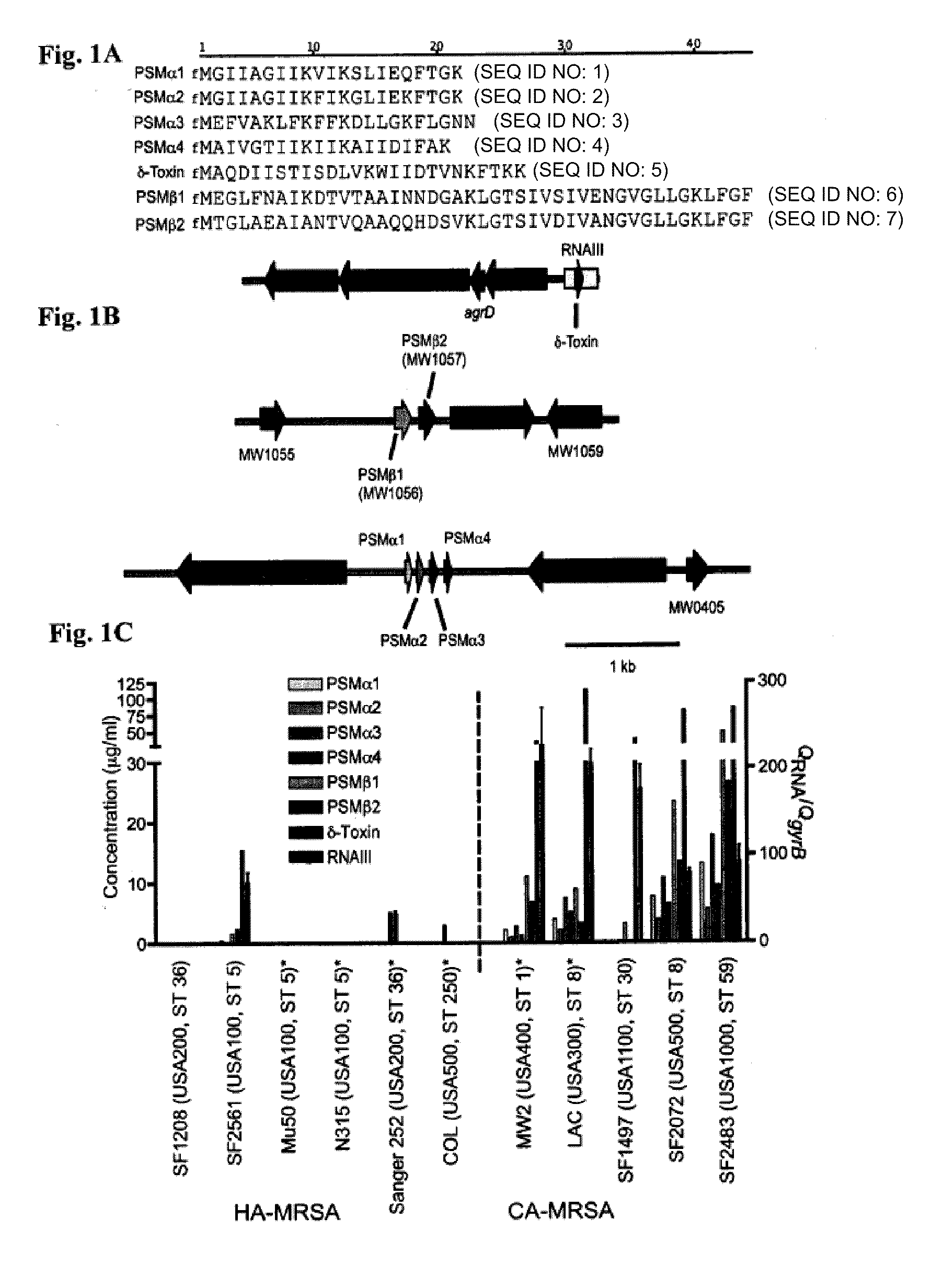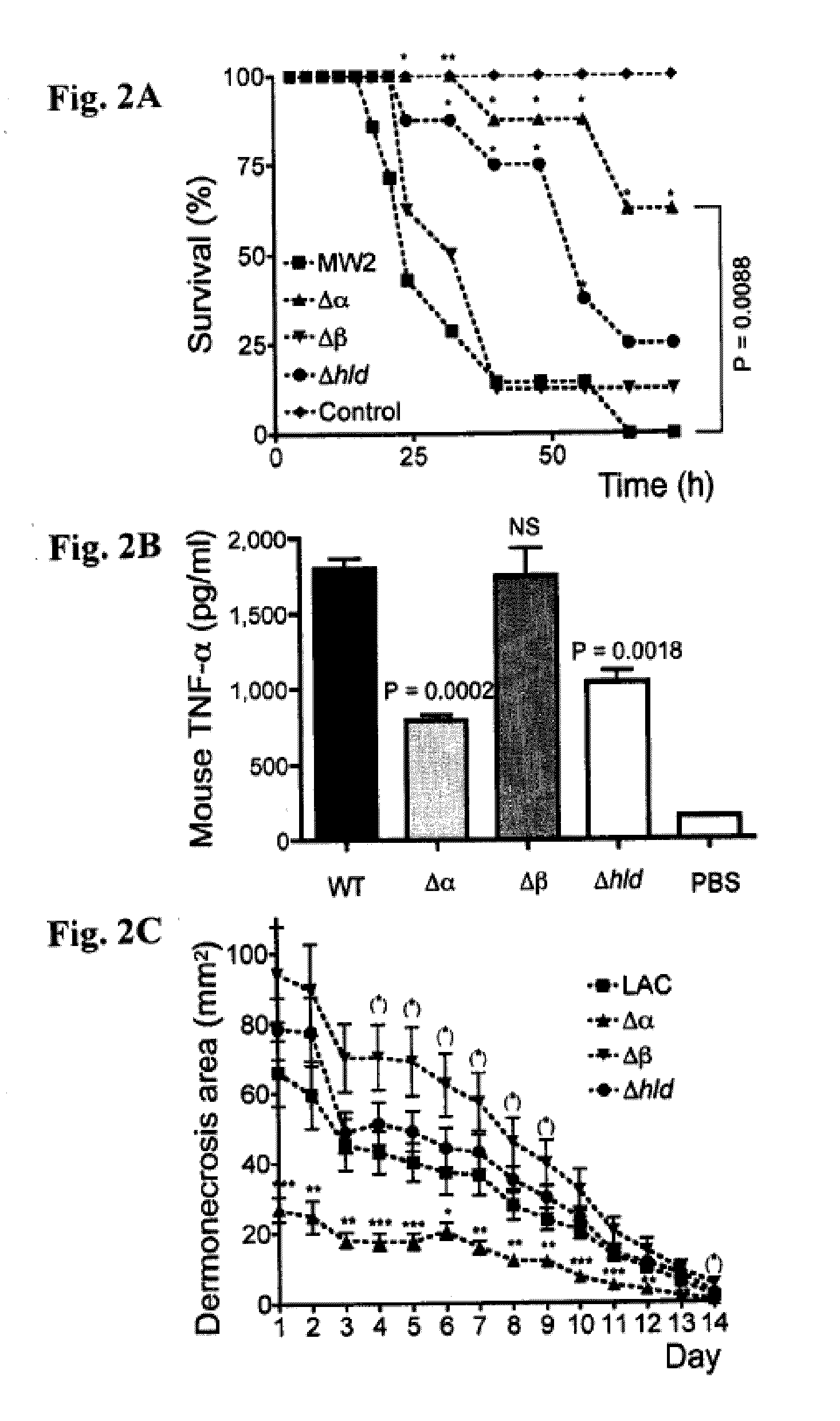Psm peptides as vaccine targets against methicillin-resistant staphylococcus
a technology of methicillin-resistant staphylococcus and immunogenic peptides, which is applied in the field of treatment and inhibition of infectious diseases, can solve the problems of severe infections, death of otherwise healthy adults, and exclusive hospitalization of mrsa infections
- Summary
- Abstract
- Description
- Claims
- Application Information
AI Technical Summary
Benefits of technology
Problems solved by technology
Method used
Image
Examples
example 1
PSMα Peptides as Vaccine Targets Against Methicillin-Resistant Staphylococcus Aureus
[0191]This Example demonstrates that PSMα peptides are major virulence determinants of S. aureus, and that their increased production in CA-MRSA contributes to the enhanced virulence of those strains compared to traditional HA-MRSA.
[0192]Among several putative determinants of CA-MRSA virulence, the Panton-Valentine leukocidin (PVL) has received most attention (Baba et al., Lancet 359, 1819-27, 2002; Diep et al., Lancet 367, 731-9, 2006; Vandenesch et al., Emerg. Infect. Dis. 9, 978-84, 2003; Gillet et al., Lancet 359, 753-9, 2002). A role of this lytic toxin as a virulence factor in cutaneous infection was suggested early (Grojec & Jeljaszewicz, Zentralbl .Bakteriol. Mikrobiol. Hyg. [A] 250, 446-55. 1981; Cribier et al., Dermatology 185, 175-80, 1992) and results from a mouse infection model indicate that purified PVL or heterologous over-expression of PVL contributes to the development of necrotizi...
example 2
Methods for FIGS. 1-5
[0201]This Example describes the methods used in generating the data shown in FIGS. 1-5.
A. Bacterial Strains
[0202]HA- and CA-MRSA were standard strains whose genomes have been sequenced (Baba et al., Lancet 359, 1819-27, 2002; Diep et al., Lancet 367, 731-9, 2006; Holden et al., Proc Natl Acad Sci USA 101, 9786-91, 2004; Gill et al., J Bacteriol 187, 2426-38, 2005; Kuroda et al., Lancet 357, 1225-40, 2001) or prototypical strains from a UCSF collection (Diep et al., J Infect Dis 193, 1495-503, 2006). Bacteria were grown in tryptic soy broth (TSB).
B. Reversed-Phase Chromatography / Mass Spectrometry
[0203]Bacterial strains were inoculated 1:100 from a pre-culture grown overnight, grown for 8 hours in TSB, and culture filtrates were obtained by centrifugation at 10,000×g for 15 minutes. For preparative chromatography, samples were precipitated with trichloroacetic acid, the precipitate was dissolved in 8 M urea, and samples were injected onto a HR 16 / 10 column packed...
example 3
Methods for FIGS. 5-10
[0219]This Example describes the methods used in generating the data shown in FIGS. 5-10.
A. Quantitative Reverse-Transcription (RT) Polymerase Chain Reaction (PCR)
[0220]Oligonucleotide primers and probes were designed with Primer Express software (version 2.0; Applied Biosystems) and synthesized by Applied Biosystems. The protocols were performed in triplicate, with 16S rRNA as a control.
B. Human neutrophil isolation
[0221]PMNs were isolated from venous blood of healthy volunteers in accordance with protocols approved by the Institutional Review Board for Human Subjects, NIAID, and the University of Tubingen, Germany.
C. Neutrophil Chemotaxis and Calcium Ion Fluxes
[0222]Neutrophils were subjected to a brief hypotonic shock with pyrogen-free water (Sigma), washed, and suspended at 5×106cells / ml in HBSS containing 0.05% human serum albumin (HAS; CLB). Chemotaxis of neutrophils was determined by using fluorescently-labeled neutrophils that migrated through a membran...
PUM
| Property | Measurement | Unit |
|---|---|---|
| concentrations | aaaaa | aaaaa |
| concentration | aaaaa | aaaaa |
| concentration | aaaaa | aaaaa |
Abstract
Description
Claims
Application Information
 Login to View More
Login to View More - R&D
- Intellectual Property
- Life Sciences
- Materials
- Tech Scout
- Unparalleled Data Quality
- Higher Quality Content
- 60% Fewer Hallucinations
Browse by: Latest US Patents, China's latest patents, Technical Efficacy Thesaurus, Application Domain, Technology Topic, Popular Technical Reports.
© 2025 PatSnap. All rights reserved.Legal|Privacy policy|Modern Slavery Act Transparency Statement|Sitemap|About US| Contact US: help@patsnap.com



